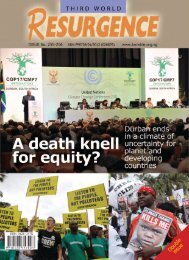Plantations, poverty and power - Critical Information Collective
Plantations, poverty and power - Critical Information Collective
Plantations, poverty and power - Critical Information Collective
Create successful ePaper yourself
Turn your PDF publications into a flip-book with our unique Google optimized e-Paper software.
19<br />
are asking for”, notes WWF. 60 In 2005, I took part in a meeting with Procter <strong>and</strong> Gamble in Germany.<br />
Shortly before the meeting, Brazil’s Aracruz, which was then supplying pulp for P&G’s Tempo br<strong>and</strong><br />
paper tissues, had violently evicted Tupinikim <strong>and</strong> Guarani indigenous peoples from villages on<br />
traditional l<strong>and</strong> that they had reclaimed from Aracruz’s plantations. During the five-hour-long meeting we<br />
discussed l<strong>and</strong> rights, Indigenous Peoples’ rights, the impact of industrial tree plantations on water, soil<br />
<strong>and</strong> local livelihoods <strong>and</strong> the ethics of importing pulp from a company such as Aracruz. But the only time<br />
the P&G staff really became animated was when we suggested that P&G could use recycled fibre to make<br />
its tissue. This was out of the question, according to P&G. “Our customers need soft tissue paper,” was<br />
the response. Millions of dollars of P&G research has revealed that the softest, fluffiest tissue paper can<br />
be manufactured from eucalyptus pulp, with layers of tissue paper manufactured from softwood pulp to<br />
provide strength.<br />
Tissue paper companies have huge budgets for advertising, aimed precisely at convincing consumers how<br />
soft their products are <strong>and</strong> how super softness is an essential quality for tissue paper. Yet much of the<br />
tissue paper that people use day-to-day is recycled. In hotels, schools <strong>and</strong> offices, most toilet paper is<br />
made from recycled paper. 61<br />
Paper can be recycled<br />
In fact, the paper industry is perfectly happy to use recycled paper for some uses. “Recycled paper has<br />
been the fastest growing fibre source for paper industry already for over 15 years, it has substituted<br />
gradually for wood-based pulp in fibre furnish,” explained Pöyry’s Petteri Pihlajamäki to Finnish<br />
researcher Tove Selin in 2004. 62<br />
Between 1991 <strong>and</strong> 2006, the use of recycled paper in member countries of the Confederation of European<br />
Paper Industries increased from about 26 million tons to about 49 million tons. 63 In 2000, the European<br />
paper industry launched a “European Declaration on Paper Recycling” which set a series of voluntary<br />
st<strong>and</strong>ards <strong>and</strong> targets for the paper industry. In 2006, the industry launched a second Declaration aiming<br />
to increase the paper recycling rate in Europe to 66 per cent by 2010. 64<br />
However, while the proportion of paper manufactured from recycled paper has more than doubled since<br />
the 1960s (from about 20 per cent in 1961 to 46 per cent in 2005), the overall production of paper is still<br />
increasing. 65 In other words, the total amount of paper manufactured from trees increases each year.<br />
60 “Forests flushed down the toilet”, WWF press release, 21 November 2005.<br />
61 “Forests flushed down the toilet”, WWF press release, 21 November 2005.<br />
62 Tove Selin (2004) “Jaakko Pöyry <strong>and</strong> the Fin(n)ished Forests of the Mekong Region”, Watershed, Vol. 9, No. 3, March-<br />
June 2004. http://terraper.org/pic_water/Watershed%209(3).pdf<br />
63 “Key Statistics 2006 European Pulp <strong>and</strong> Paper Industry”, Confederation of European Paper Industries, 2007.<br />
64 “European Declaration on Paper Recycling 2006-2010”, European Recovered Paper Council, c/o CEPI, 2006. The<br />
following European associations are Signatories to the European Declaration on Paper Recycling:<br />
CITPA – International Confederation of Paper <strong>and</strong> Board Converters in Europe<br />
ERPA – European Recovered Paper Association<br />
ETS – European Tissue Symposium<br />
INGEDE – International Association of the Deinking Industry<br />
INTERGRAF – International Confederation for Printing <strong>and</strong> Allied Industries<br />
65 The statistics come from World Resources Institute’s Earthtrends website:<br />
http://earthtrends.wri.org/searchable_db/index.phpaction=select_variable&theme=9. WRI’s source is the UN Food <strong>and</strong><br />
Agriculture Organization’s 2007 FAOSTAT on-line statistical service: http://faostat.fao.org/default.aspx















